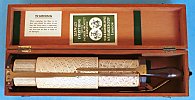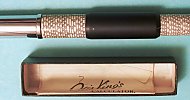Circular slide rules got somewhat more scale length by wrapping the scales around a circle. Cylindrical instruments, got far greater length by wrapping the scale in a spiral around a cylinder.
This Fuller Calculator made in England by Stanley was less than 18" long including the handle yet due to the spiral layout, its scale was 41 feet long. The slide rule consisted of three concentric cylinders. The outermost cylinder was 6" long and contained the 41' log scale. It could be pushed, pulled and rotated along the length of the middle cylinder. The middle cylinder was 12" long and was printed with information that varied based on the model. (The model 2 pictured had sine and log scales.) The middle cylinder was not used for multiplying as this was a single log-scale/multiple pointer device like the Fowler. The inner cylinder had no scales at all and served to allow the pointer/index that was attached to it to be rotated, pushed and pulled relative to the two labeled cylinders.
There were three brass pointers or indexes. The F (fixed) pointer was attached to the base of the middle cylinder. The A and B pointers were part of the same piece of metal. The appropriate one to use depended on the calculation. (Only one of A and B was used per calculation.) Since these pointers were attached to the base of the central cylinder, they could be rotated and pulled/pushed to change their positions along the cylinders. These pointers could be freely rotated all the way around because the fixed pointer was designed to slide over them.
To multiply X by Y, the outer cylinder was rotated/pushed to bring X to the fixed pointer. The inner cylinder was then rotated/pushed to bring A or B to 1 on the outer cylinder. The outer cylinder was then rotated/pushed to bring Y to A or B and the product could then be read at the fixed pointer F. This could be chained as needed. (This was the same method used on the Fowler's calculator only the movements were in more dimensions.)
The calculator was made of Bakelite and brass and came in a dovetailed mahogany box with a brass stand. This model was introduced in the 19th century, however the museum's copy was made in 1948.

|
Picture of the 41-foot Fuller Calculator in its box. As in all the pictures, the inner cylinder is pushed all the way in. The instrument could become up to twice the length shown. |

|
Picture on its stand on its box |

|
Closeup on the scale and slide |
This Otis King model K calculator had a much smaller cylinder than the Fuller allowing it to be carried in a pocket. It was just 6" long by 1.2" in diameter when closed yet it had scales 66" long. Usage was similar to the Fuller rule above but both pointers were engraved on a single cursor. (The black outer cylinder.) To multiply A x B, the bottom pointer was set to A, the top cylinder was moved to set the top pointer to one and the cursor was moved to set the top pointer to B. The result could then be read from the bottom pointer.

|
Picture of an Otis King Calculator. (Its box is also shown to indicate its closed size.) |
The Museum has many more slide rules. Another 30 or so are on display. Including models for electrical and pump calculations.
![]() Back to early models contents
Back to early models contents
![]() Go on to more slide rules
Go on to more slide rules
![]() Back to circular slide rules
Back to circular slide rules